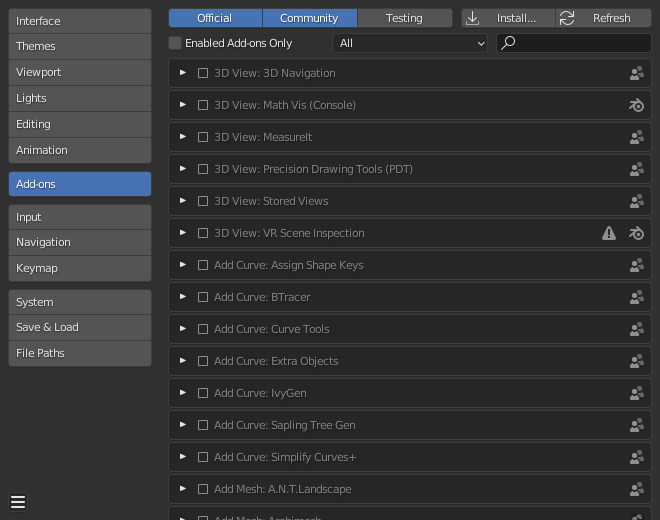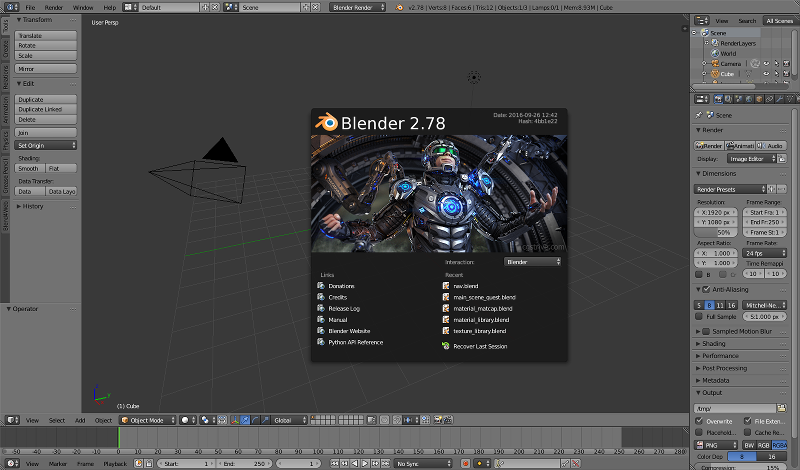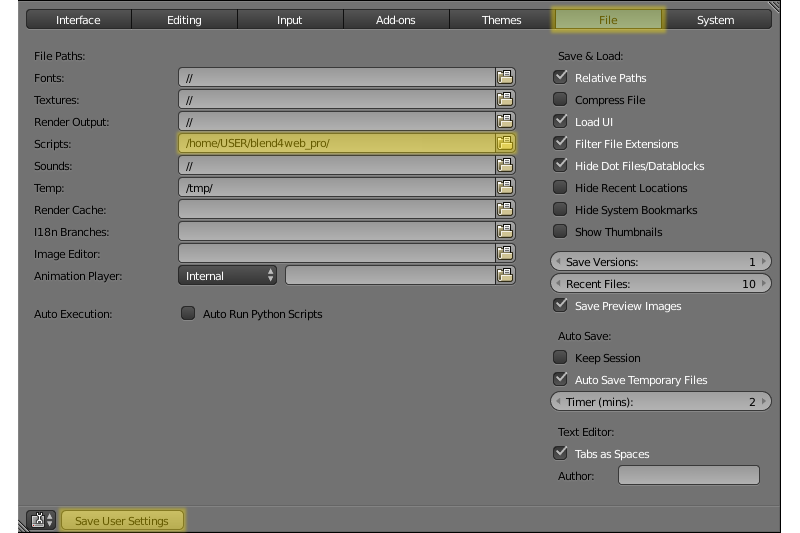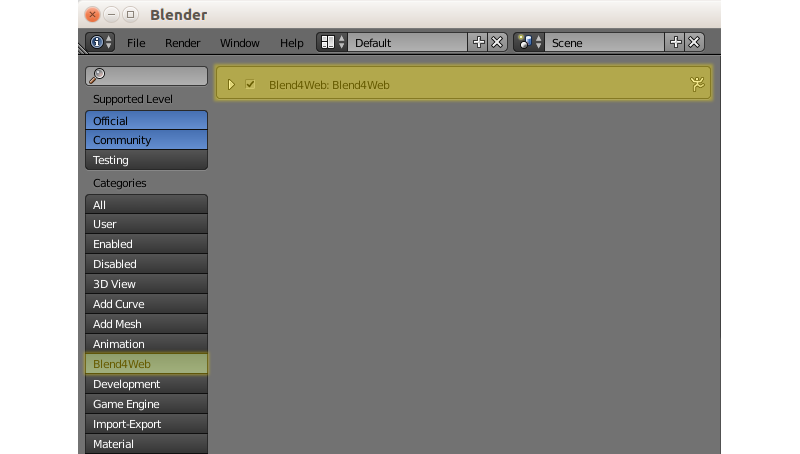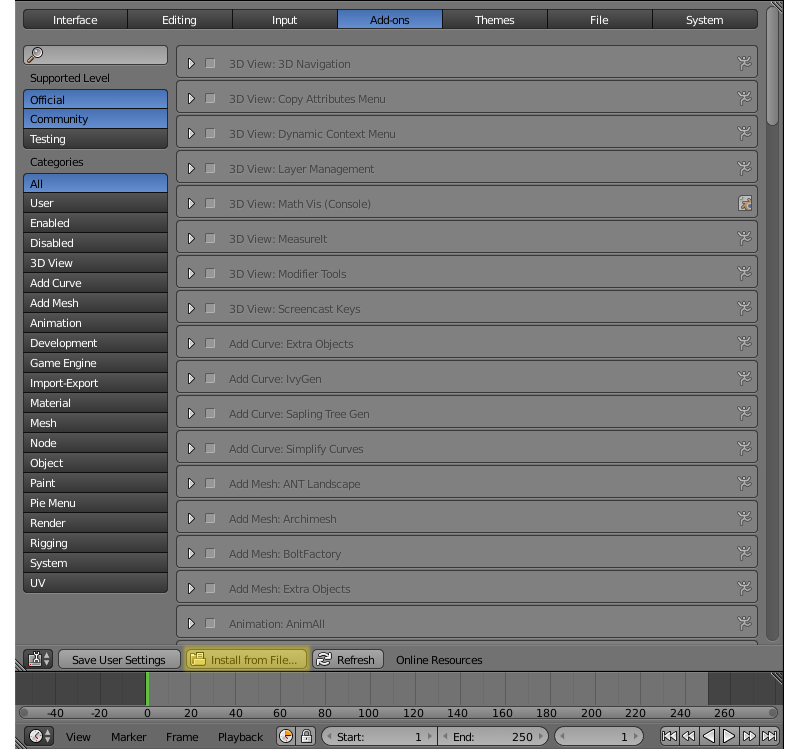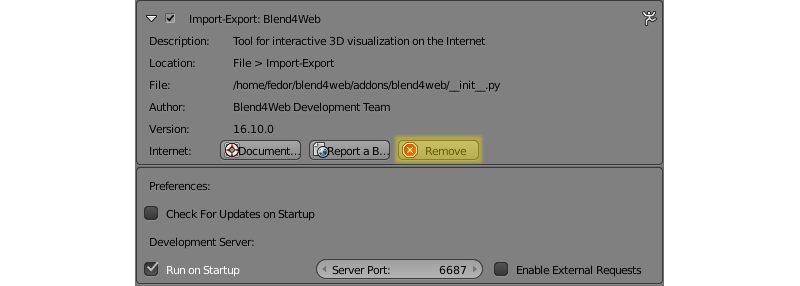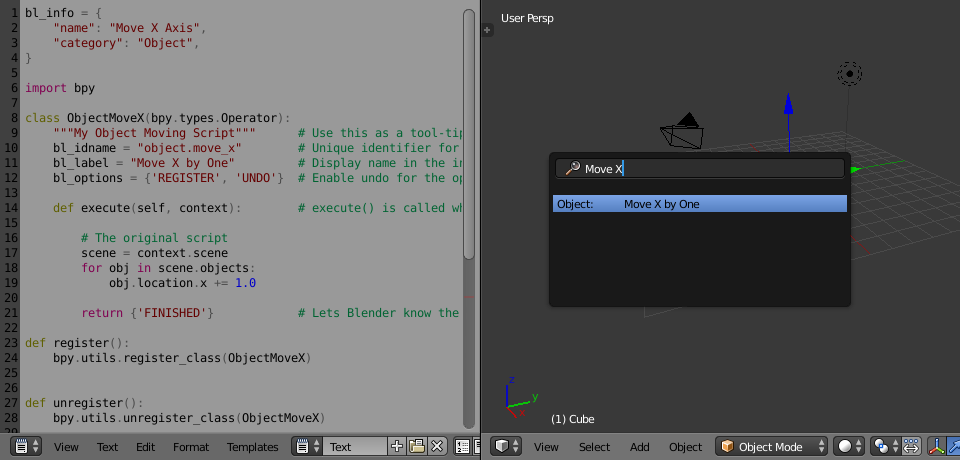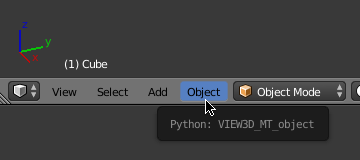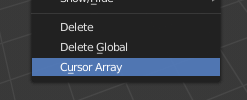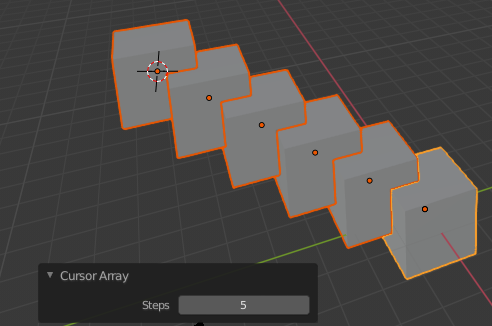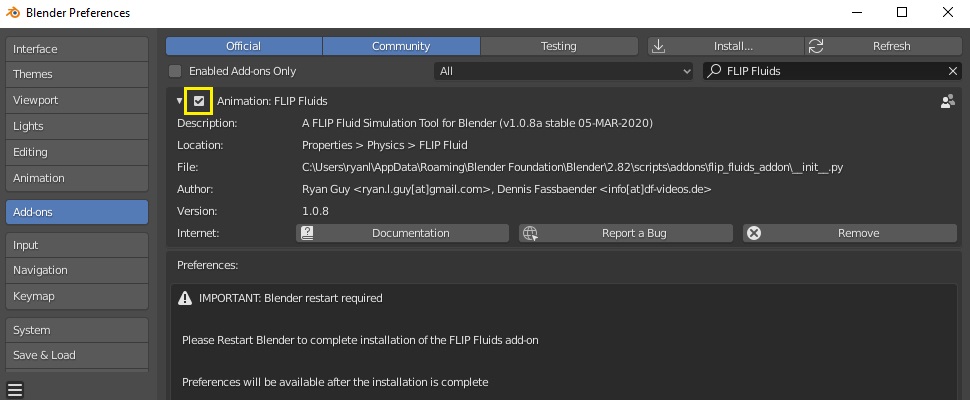Как установить аддон в blender
Как установить аддон в blender
Add-onsпѓЃ
The Add-ons section lets you manage secondary scripts, called “Add-ons” that extends Blender’s functionality. In this section you can search, install, enable and disable Add-ons.
Blender Preferences Add-ons section. пѓЃ
Finding Add-onsпѓЃ
Blender comes with some pre-installed Add-ons already, ready to be enabled. But you can also add your own, or any interesting ones you find on the web.
Blender’s add-ons are split into two groups depending on who writes/supports them:
Official: Add-ons that are written by Blender developers.
Community: Add-ons that are written by people in the Blender community.
Enabled Add-ons Only
Shows only enabled add-ons for the current Category.
Add-ons are divided into categories by what areas of Blender they affect.
Installing Add-onsпѓЃ
There are hundreds of add-ons that are not distributed with Blender and are developed by others. To add them to the list of other add-ons, they must be installed into Blender.
Now the add-on will be installed, however not automatically enabled. The search field will be set to the add-on’s name (to avoid having to look for it), Enable the add-on by checking the enable checkbox.
Scans the Add-on Directory for new add-ons.
User-Defined Add-on Path
You can also create a personal directory containing new add-ons and configure your files path in the File Paths section of the Preferences. To create a personal script directory:
Create an empty directory in a location of your choice (e.g. my_scripts ).
Add a subdirectory under my_scripts called addons (it must have this name for Blender to recognize it).
Open the File Paths section of the Preferences.
Set the Scripts file path to point to your script directory (e.g. my_scripts ).
Save the preferences and restart Blender for it to recognize the new add-on location.
Now when you install add-ons you can select the Target Path when installing 3rd party scripts. Blender will copy newly installed add-ons under the directory selected in your Preferences.
Enabling & Disabling Add-onsпѓЃ
To enable or disable an add-on check or uncheck the box to the right of the add-ons shown in the figure below.
The add-on functionality should be immediately available.
Add-ons that activate or change multiple hotkeys have a special system of activation. For example, with the 3D Viewport Pie Menus add-on for each menu there is a selection box to activate the menu and its hotkey.
If the Add-on does not activate when enabled, check the Console window for any errors that may have occurred.
Add-on InformationпѓЃ
You can click the arrow at the left of the add-on box to see more information, such as its location, a description and a link to the documentation. Here you can also find a button to report a bug specific of this add-on.
Add-on PreferencesпѓЃ
Some add-ons may have their own preferences which can be found in the Preferences section of the add-on information box.
Some add-ons use this section for example to enable/disable certain functions of the add-on. Sometimes these might even all default to off. So it is important to check if the enabled add-on has any particular preferences.
© Copyright : This page is licensed under a CC-BY-SA 4.0 Int. License. Last updated on 07/28/2022.
Уроки от Хаки
Как установить аддон в Blender’е (2.8х)
Всем привет! Дошли наконец-таки руки перевести основные уроки в небольшие статьи. Видео можете посмотреть здесь (желательно на ютубе, конечно):
Быстрый способ
Заходим в Edit > Preferences или жмём Ctrl + Alt + U (старайтесь сразу запоминать горячие клавиши!)
Изменить тип окна на «Info» Теперь вы хотя бы знаете, где искать ошибки.
Но если всё прошло хорошо, но у вас не стоит Auto-Save Preferences (а я советую не ставить авто-сохранение для большего контроля), то при закрытие и последующем открытие блендера наш установленный аддон будет снова выключен. Если вы уверены, что этот аддон должен быть включен всегда (что замедлит загрузку программы), то нажмите Save Preferences слева внизу окна.
Ctrl + Alt + U > Add-ons > Install… > Выбрать файл > Install Add-on > Поставить галочку (включить аддон) > При желании сохранить настройки
Перемещение в папку с аддонами
В этом способе также нет ничего сложного, разве что найти нужную папку может быть муторно. А то, что их ещё и как минимум две существует, делу как-то не помогает.
Итак, первая папка находится непосредственно там же, где и установлен ваш блендер:
*Путь к Блендеру* \Blender Foundation\Blender 2.81 (или другая версия) \2.81 (или другая версия) \scripts\addons
Именно в папку «addons» и нужно перемещать наши файлы.
Другая же директория отличается именно той частью, которая «Путь к Блендеру», а если точнее, то находится в папке «Roamig». Именно в эту папку устанавливаются аддоны с помощью предыдущего способа.
Путь выглядит похоже, самое сложное — найти папку «Blender Foundation», остальное всё идентично.
C:Users\Username (ваше имя пользователя) \AppData\Roamig\Blender Foundation\Blender 2.81 (или другая версия) \2.81 (или другая версия) \scripts\addons
Вы можете посмотреть точный путь в графе «File» в установленном первыс способом аддоне.
Pullusb/How_to_install_Blender_addons
Latest commit
Git stats
Files
Failed to load latest commit information.
README.md
First, dear user, know that there can be two types of addon files
Single file addon:
Just a plain python file «the_addon_name.py«
The easy (user friendly) Way
Go to preferences, addons, click on «install. » to look for either the «.py» or the «.zip«.
Then just click on the enable checkbox.
If you dont want to bother more, this is the only method you need to know (except if the addon use modules, most of them don’t). So you can stop here. But! The rest will be usefull to manage your addon more efficiently and personally.
Once an addon is manually installed in sources folders. You’ll have to click on the refresh button to see it.
Let’s see where addons (and python modules) are stored and the differences of these locations.
There are 3 places :
Placed in installation folder.
Something like : C:\Program Files\Blender Foundation\Blender\2.80\scripts\addons\
«Release» addons (those who are built-in when you download blender) are stored inside the script folder of the blender datas.
These are local to this blender version only, you can put your downloaded addon here, but the next place is precisely designed for them.
note that the intermediate RC (release candidate) versions also come with a lot more of «contrib» addons for you to test. If integrated, these are stored inside «addons_contrib» just aside «addons» folder. The «contrib» are those who didn’t make it to the release for various reason but are usually solid and powerfull stuff.
Placed in user apps configs.
Somewhere like this:
on windows: C:/Users/username/AppData/Roaming/Blender Foundation/Blender/2.80/scripts/addons
on linux:
This is where your file actually goes when you use the automatic install!
Here is what happens when you click on install addon:
note : If you never installed addons from the «install» button the folder probably wont be there. You have to create «addons» (and eventually «modules») if there are not in ‘scripts’.
Bonus : For the same reason, that’s also where your preferences are stored, aside the «script» folder there is a «config» that contains userpref.blend, startup.blend, file-history, etc.
Placed in a folder of your choice (optional and not set by default).
This place is defined by you in the preferences and allow a third folder to be scanned for addons and modules.
You add the path in Preferences > File Paths > Scripts
As mentionned in the official doc, the folder that you target must have the same directory structure as the two other location.
In the directory that you point (you do not have to name it ‘scripts’) create a subfolder «addons» (and the folder «modules» if you need it)
This folder is interesting because you can even set the path to a local server for exemple. So all the computer on the same network can load the same addons and updating the file will update for all.
That’s it, now you know where the addons files are stored, you can manage them your own way. 👍
Final note : In the addon DevTools you have buttons to open these locations from blender in the text-editor toolbar.
Add-ons¶
The Add-ons tab lets you manage secondary scripts, called «Add-ons» that extends Blender’s functionality. In this tab you can search, install, enable and disable Add-ons.
Add-ons tab in the User Preferences.
Searching¶
Blender comes with some useful Add-ons already, ready to be enabled. But you can also add your own, or any interesting ones you find on the web.
Filtering¶
Blender’s add-ons are split into two groups depending on who writes/supports them:
Enabling and Disabling¶
Enable and disable an add-on by checking or unchecking the box on the right of the add-on you chose, as shown in the figure.
The add-on functionality should be immediately available. If the Add-on does not activate when enabled, check the Console window for any errors, that may have occurred.
Add-on Information¶
You can click the arrow at the left of the add-on box to see more information, such as its location, a description and a link to the documentation. Here you can also find a button to report a bug specific of this add-on.
Saving Add-on Preferences
If you want an Add-on to be enabled every time you start Blender, you will need to Save User Settings.
Add-on Preferences¶
Individual Activation¶
Add-ons that activate or change multiple hotkeys now have a special system of activation. For example, with the «UI: Pie Menu Official» add-on for each menu there’s a selection box to activate the menu and its hotkey.
With Pie menus, First you activate the add-on. This activates the «Add-ons Preferences Submodule Activation». You then need to expand the Add-ons Preferences, then you will see the list of Pie Menu types you can choose from. From here you can individually activate the menus you like to use. If the menu conflicts with another favorite, there’s no need to activate it. You can activate any combination and save as user settings so your activations are available next time you start Blender.
Header¶
Now the add-on will be installed, not automatically enabled. The search field will be set to the add-on’s name (to avoid having to look for it). Enable the add-on by turning on the checkbox.
Refresh Scans the Add-on Directory for new add-ons. Online Resources
This menu contains a list of helpful links for both users and people who are interested in writing their own add-on.
Scripts Catalog Provides an index of Add-ons that are included with Blender as well as listing a number of external Add-ons. How to share your add-on Information on how to get your add-on into Blender. Add-ons development guidelines Guidelines on writing new add-on that you might want to get into Blender. API Concepts A quick introduction to Blender’s API. Add-on Tutorial A quick tutorial on the essentials of writing an add-on.
User-Defined Add-on Path
You can also create a personal directory containing new add-ons and configure your files path in the File tab of the User Preferences. To create a personal script directory:
Now when you install add-ons you can select the Target Path option to User Pref (from the File tab).
Blender will copy newly installed add-ons under the directory selected in your User Preferences.
© Copyright : This page is licensed under a CC-BY-SA 4.0 Int. License.
Установка и обновление¶
Установка¶
Существуют две версии фреймворка Blend4Web: Blend4Web SDK и аддон Blend4Web. Какую из них вам следует выбрать для работы, зависит от того, приложения какого типа вы планируете разрабатывать.
Если вы планируете использовать все возможности движка Blend4Web, вам следует установить Blend4Web SDK.
Если же вы планируете разрабатывать небольшие проекты или собираетесь использовать только некоторые возможности движка Blend4Web (например, редактор нормалей), вы можете использовать аддон Blend4Web вместо SDK.
Установка программы Blender¶
Создание 3D сцен осуществляется в графическом пакете Blender, который является программным продуктом с открытым исходным кодом и распространяется бесплатно.
Перед установкой необходимо загрузить и установить совместимую версию Blender, согласно таблице.
Должна использоваться текущая стабильная версия Blender. Загрузить Blender можно с официального сайта или с сайта Blend4Web.
Установка Blend4Web SDK¶
Стабильные версии дистрибутива поставляются в виде архива ( blend4web_ce_YY_MM.zip – бесплатный SDK, blend4web_pro_YY_MM.zip – коммерческий SDK). Достаточно распаковать данный архив в любое место на диске.
В поле Scripts прописать путь к директории SDK.
Нажать Save User Settings
Ещё раз нажать Save User Settings
Установка аддона Blend4Web¶
Устанавливается так же, как любой другой аддон Blender.
Найдите аддон Blend4Web в списке.
Активируйте его, поставив флажок слева от названия аддона.
Теперь всё должно работать.
Переключение в режим Blend4Web¶
Выберите профиль настроек Blend4Web в выпадающем меню верхней панели:
Обновление¶
Обновление SDK¶
При обновлении SDK следуйте этой инструкции:
Загрузите новую версию SDK.
Не рекомендуется использовать кнопку Remove для отключения аддона при обновлении SDK, так как это приведёт к полному удалению аддона, в том числе его файлов в SDK.
Разархивируйте новую версию SDK.
Обновление может производиться одним из двух способов.
Во-первых, вы можете полностью удалить каталог SDK, после чего распаковать каталог с новой версией и прописать путь к ней в настройках Blender, как если бы вы устанавливали SDK с нуля.
Во-вторых, вы можете просто перезаписать устаревшие файлы SDK новыми. Этот подход считается менее “чистым”, но в большинстве случаев не должен приводить к проблемам.
В поле Scripts пропишите путь к директории SDK.
Проверьте, всё ли работает правильно.
Обновление аддона¶
В том случае, если вы используете только аддон Blend4Web, следуйте этой инструкции.
Загрузите архив, содержащий новую версию аддона, и сохраните его в любом месте на жёстком диске.
Установите новую версию аддона из загруженного архива.
Теперь всё должно работать.
Обновление сохранённых проектов¶
После обновления SDK (или аддона) вы можете импортировать в Менеджер проектов проекты, экспортированные перед началом обновления. Чтобы сделать это, следуйте инструкции:
Откройте Менеджер проектов.
Затем используйте команду build для того, чтобы собранные версии импортированных проектов нормально работали с новой версией SDK.
Add-on TutorialпѓЃ
Intended AudienceпѓЃ
This tutorial is designed to help technical artists or developers learn to extend Blender. An understanding of the basics of Python is expected for those working through this tutorial.
PrerequisitesпѓЃ
Before going through the tutorial you should…
Be familiar with the basics of working in Blender.
Know how to run a script in Blender’s Text editor.
Have an understanding of Python primitive types (integer, Boolean, string, list, tuple, dictionary, and set).
Be familiar with the concept of Python modules.
Have a basic understanding of classes (object orientation) in Python.
Suggested reading before starting this tutorial.
Dive Into Python sections (1, 2, 3, 4, and 7).
Blender API Quickstart to help become familiar with Blender/Python basics.
To best troubleshoot any error message Python prints while writing scripts, you run Blender from a terminal. See Use The Terminal.
You can enable Developer Extras in the preferences to enable features that make developing add-ons easier.
Documentation LinksпѓЃ
While going through the tutorial, you may want to look into our reference documentation.
Blender API Overview: This document is rather detailed but helpful if you want to know more on a topic.
bpy.context API reference – Handy to have a list of available items your script may operate on.
bpy.types.Operator – The following add-ons define operators, these docs give details and more examples of operators.
What is an Add-on?пѓЃ
An add-on is simply a Python module with some additional requirements so Blender can display it in a list with useful information.
To give an example, here is the simplest possible add-on:
is a dictionary containing add-on metadata such as the title, version and author to be displayed in the Preferences add-on list. It also specifies the minimum Blender version required to run the script; older versions won’t display the add-on in the list.
is a function which only runs when enabling the add-on, this means the module can be loaded without activating the add-on.
Notice this add-on does not do anything related to Blender (the blender_api:bpy module is not imported for example).
This is a contrived example of an add-on that serves to illustrate the point that the base requirements of an add-on are simple.
An add-on will typically register operators, panels, menu items, etc, but it’s worth noting that any script can do this, when executed from the Text editor or even the interactive console – there is nothing inherently different about an add-on that allows it to integrate with Blender, such functionality is just provided by the blender_api:bpy module for any script to access.
So an add-on is just a way to encapsulate a Python module in a way a user can easily utilize.
Running this script within the Text editor won’t print anything, to see the output it must be installed through the Preferences. Messages will be printed when enabling and disabling.
Your First Add-onпѓЃ
The simplest possible add-on above is useful as an example but not much else. This next add-on is simple but shows how to integrate a script into Blender using an Operator which is the typical way to define a tool accessed from menus, buttons and keyboard shortcuts.
For the first example we will make a script that simply moves all objects in a scene.
Write the ScriptпѓЃ
Add the following script to the Text editor in Blender:
Write the Add-on (Simple)пѓЃ
This add-on takes the body of the script above, and adds it to an operator’s execute() function.
bl_info is split across multiple lines, this is just a style convention used to more easily add items.
To test the script, you can copy and paste it into Blender’s Text editor and run it. This will execute the script directly and call register immediately.
However running the script won’t move any objects. For this, you need to execute the newly registered operator.
Operator Search menu. пѓЃ
The objects should move as before.
Install the Add-onпѓЃ
Once you have your add-on within in Blender’s Text editor, you will want to be able to install it so it can be enabled in the Preferences to load on startup.
Even though the add-on above is a test, let’s go through the steps anyway so you know how to do it for later.
Once the file is on drive, you can install it as you would for an add-on downloaded online.
Open the Preferences ‣ Add-ons ‣ Install… and select the file.
When the add-on is enabled, Blender executes the code and runs the register() function. When the add-on is disabled, Blender runs the unregister() function.
The destination of the add-on depends on your Blender configuration. When installing an add-on the source and destination paths are printed in the console. You can also find add-on path locations by running this in the Python Console:
Your Second Add-onпѓЃ
For our second add-on, we will focus on object instancing – this is – to make linked copies of an object in a similar way to what you may have seen with the Array modifier.
Write the ScriptпѓЃ
As before, first we will start with a script, develop it, then convert it into an add-on.
Now try copying this script into Blender and run it on the default Cube. Make sure you click to move the 3D cursor before running as the duplicate will appear at the cursor’s location.
After running, notice that when you go into Edit Mode to change the Cube – all of the copies change. In Blender, this is known as Linked Duplicates.
Next, we’re going to do this in a loop, to make an array of objects between the active object and the cursor.
Try running this script with the active object and the cursor spaced apart to see the result.
With this script you’ll notice we’re doing some math with the object location and cursor, this works because both are 3D mathutils.Vector instances, a convenient class provided by the mathutils module which allows vectors to be multiplied by numbers and matrices.
If you are interested in this area, read into mathutils.Vector – there are many handy utility functions such as getting the angle between vectors, cross product, dot products as well as more advanced functions in mathutils.geometry such as Bézier spline interpolation and ray-triangle intersection.
For now we will focus on making this script an add-on, but it’s good to know that this 3D math module is available and can help you with more advanced functionality later on.
Write the Add-onпѓЃ
The first step is to convert the script as-is into an add-on:
Everything here has been covered in the previous steps, you may want to try run the add-on still and consider what could be done to make it more useful.
The two of the most obvious missing things are – having the total fixed at 10, and having to access the operator with Search is not very convenient.
Both these additions are explained next, with the final script afterwards.
Operator PropertyпѓЃ
There are a variety of property types that are used for tool settings, common property types include: int, float, vector, color, Boolean and string.
These properties are handled differently to typical Python class attributes because Blender needs to display them in the interface, store their settings in keymaps and keep settings for reuse.
While this is handled in a fairly Pythonic way, be mindful that you are in fact defining tool settings that are loaded into Blender and accessed by other parts of Blender, outside of Python.
These properties from bpy.props are handled specially by Blender when the class is registered so they display as buttons in the user interface. There are many arguments you can pass to properties to set limits, change the default and display a tooltip.
This document doesn’t go into details about using other property types. However, the link above includes examples of more advanced property usage.
Menu ItemпѓЃ
Add-ons can add to the user interface of existing panels, headers and menus defined in Python.
For this example we’ll add to an existing menu.
To find the identifier of a menu, first enable Python Tooltips in the preferences. Then you can hover your mouse over the menu item and the identifier is displayed.
The method used for adding a menu item is to append a draw function into an existing class:
KeymapпѓЃ
In Blender, add-ons have their own keymaps so as not to interfere with Blender’s built-in keymaps.
Notice how the keymap item can have a total setting different than the default set by the operator, this allows you to have multiple keys accessing the same operator with different settings.
For API documentation on the functions listed above, see:
Bringing It All TogetherпѓЃ
Run the script (or save it and add it through the Preferences like before) and it will appear in the Object menu.
After selecting it from the menu, you can choose how many instances of the cube you want create.
Directly executing the script multiple times will add the menu each time too. While not useful behavior, there is nothing to worry about since add-ons will not register themselves multiple times when enabled through the Preferences.
ConclusionsпѓЃ
Add-ons can encapsulate certain functionality neatly for writing tools to improve your workflow or for writing utilities for others to use.
While there are limits to what Python can do within Blender, there is certainly a lot that can be achieved without having to dive into Blender’s C/C++ code.
The example given in the tutorial is limited, but shows the Blender API used for common tasks that you can expand on to write your own tools.
Further ReadingпѓЃ
Blender comes with commented templates which are accessible from the Text editor’s header. If you have specific areas you want to see example code for, this is a good place to start.
Here are some sites you might like to check on after completing this tutorial.
Blender/Python API Overview – For more background details on Blender/Python integration.
How to Think Like a Computer Scientist – Great info for those who are still learning Python.
Blender Development (Wiki) – Blender Development, general information and helpful links.
DevTalk – Forum where people ask Python development questions.
© Copyright : This page is licensed under a CC-BY-SA 4.0 Int. License. Last updated on 07/28/2022.
Топ-12 платных и бесплатных аддонов для Blender
Не проходит и дня без выпуска нового аддона для Blender. Из-за этого бывает трудно найти особо полезное и ценное. Предоставляем список из 12 лучших аддонов для Blender, которые сделают жизнь проще.
#1 Asset Flinger
Позволяет легко и быстро импортировать объекты в другие сцены
Один из самых крутых бесплатных аддонов, который ускорит рабочий процесс в несколько раз. Он добавляет новую вкладку в Blender, которая позволяет получить доступ ко всем активам и легко импортировать их в сцену одним щелчком мыши.
#2 RetopoFlow
Позволяет делать ретопологию сетки намного быстрее и гораздо проще.
Наверное, самый качественный платный аддон для Blender.
Когда вы что-то скульптите, то обычно не задумываетесь о структуре сетки. Из-за этого полученная сетка получается безобразна. Но чтобы наложить текстуры, анимировать их, или просто сделать рендер, всё это нужно преобразовать его в более чистую сетку. Этот аддон позволяет сделать это намного быстрее и проще, чем при использовании стандартного подхода.
#3 The Grove
Генерирует красивые деревья.
Работает так же, как и Sapling Addon, поставляемый вместе с Blender, однако имеет более продвинутые функции и упрощенный интерфейс для удобного создания деревьев. Он по-прежнему ограничен стандартными операторами Blender, что накладывает некоторые ограничения, но всё же это лучший инструмент для создания деревьев, доступный в настоящее время.
#4 EasyFX
Позволяет очень быстро добавлять эффекты в рендер
Не секрет, что для выполнения базовых задач в композиторе (например, для добавления виньетки), требуется слишком много действий. Данный аддон даст вам множество наиболее часто используемых эффектов и настроек прямо в редакторе изображений.
#5 Mirage
Позволяет легко создавать сложные ландшафты
Если вы художник, работающий в сфере ландшафтов, перед которым стоит задача создать огромный пейзаж, этот аддон сэкономит вам часы.
Цена: 25$ | Купить | Инструкция
Автор: Diego Gangl
#6 Matalogue
Дает быстрый доступ ко всем материалам и источникам света в сцене
Создание сложных сцен означает работу с большим количеством материалов, источников света и композиционных настроек. Этот аддон для Blender от Greg Zaal облегчает работу в разы, предоставляя доступ ко всему этому на одной вкладке в редакторе узлов.
Цена: Бесплатно! | Загрузить
Автор: Greg Zaal
#7 Asset Sketcher
Позволяет быстро расставлять объекты, «нарисовав» их в сцене
Размещение активов/объектов вручную в сцене может быть довольно утомительным. Но, к счастью, этот аддон облегчает работу и делает ее более удобной для художника, используя подход «рисования» для размещения объектов.
Цена: 29,95$ | Купить
Автор: Andreas Esau, Matthias Esau
#8 Animation Nodes
Позволяет анимировать практически все в Blender!
Этот аддон воплощает в жизнь параметрическое моделирование и анимацию! Вы можете вводить значения нодов, которые будут управлять свойствами объекта. По умолчанию это возможно через Blender (через программирование на Python), но этот аддон делает всё интуитивно понятным и простым в использовании.
Цена: Бесплатно! | Загрузить
Автор: Jacques Lucke
#9 BakeTool
Простое запекание текстур в Blender
Этот аддон делает процесс и рабочий процесс более простым и намного более управляемым. Он заполняет всю информацию о затенении и освещении на объектах, поэтому теперь не нужно повторять рендер всех кадров в анимации.
#10 BLAM Blender Camera Calibration Toolkit
Определяет угол и перспективу на фотографии
Этот аддон позволяет комбинировать фотографию с объектами на сцене. Он точно угадывает фокусное расстояние и угол на фотографии, так что вы можете легко поместить рендер поверх.
Цена: бесплатно! | Загрузить
Автор: Per Gantelius
#11 IK-Text Effects
Добавляет спецэффекты к любому тексту в Blender
Это мощный набор инструментов для анимации текста в Blender.
Даёт полный контроль над всеми источниками освещения в сцене
Цена: 17,95$ | Купить | Инструкция
Автор: Greg Zaal
Addon Installation and Uninstallation
Clone this wiki locally
These instructions will detail how to install or uninstall the FLIP Fluids addon for Blender 2.8+ or later. Instructions for Blender 2.79 can be found on this page: Addon Installation and Uninstallation (Blender 2.79).
Installing the Addon
Only one version of the addon should be installed at a time. If you are updating the addon to a new version, the previous version must be first uninstalled.
The easiest way to install the FLIP Fluids addon is to do so through directly through Blender:
Uninstalling the Addon
Only one version of the addon should be installed at a time. If you are updating the addon to a new version, the previous version must be first uninstalled. The easiest way to uninstall the addon is to do so directly through Blender:
Note: If you are updating the addon to a new version, Blender should be restarted after uninstalling the previous version. This will ensure that all loaded scripts from the previous version are properly unloaded and do not cause any conflicts with the new version.
Updating the Addon
Before updating to a new version, you must first uninstall the previous version. The safest way to update to a new version is to:
See our Addon Installation Troubleshooting documentation for how to verify your FLIP Fluids installation file, verify your FLIP Fluids installation, and for how to manually install the FLIP Fluids addon.
Baking Error: AttributeError: ‘array.array’ object has no attribute ‘tostring’
If you are receiving this error message in Blender 2.93 or later, this will indicate that there is a compatibility error between your installed FLIP Fluids addon version and installed Blender version. You will need to update your FLIP Fluids addon version to at least v1.0.9b or later. FLIP Fluids version 1.0.9b adds compatibility support for Blender 2.93. FLIP Fluids version 1.2.0 adds compatibility support for Blender 3.0.
Baking Error: ‘The fluid engine version is not compatible with the addon version ‘
If you are receiving this error message (or a similar error) when trying to use the Bake operator, this may indicate that multiple versions of the FLIP Fluids addon are installed on your version of Blender and that a new installation was not able to overwrite an older file due to the previous version being in use.
The first thing to try is to restart Blender and test if the error still persists. If you are still getting an error message, uninstall and reinstall the addon. Make sure to follow the installation guide of restarting Blender before and after installation (See Updating the Addon).
Installation error: ‘RNA_Types’ object has no attribute ‘PHYSICS_PT_add’
This error is caused by a conflict with the Blend4Web addon. You will need to disable the Blend4Web addon to use the FLIP Fluids addon. This error has been reported to the Blend4Web developers here.
Installation error: ‘cannot import name MappingProxyType’
This error can be caused by placing the FLIP Fluids addon files in the incorrect location, such as directly in the scripts/addons directory instead of in the correct scripts/addons/flip_fluids_addon subfolder. To fix this error, delete the file scripts/addons/types.py which is causing a conflict with Blender’s script files.
Uninstallation error: ‘[WinError 5] Access is Denied’
This error means that the fluid engine is in use and Blender is unable to remove it. Simply restart Blender and try again.
kevikoech/blender_addon_tutorial
Latest commit
Git stats
Files
Failed to load latest commit information.
readme.rst
This tutorial is designed to help technical artists or developers learn to extend Blender. An understanding of the basics of Python is expected for those working through this tutorial.
Before going through the tutorial you should.
Suggested reading before starting this tutorial.
While going through the tutorial you may want to look into our reference documentation.
An addon is simply a Python module with some additional requirements so Blender can display it in a list with useful information.
To give an example, here is the simplest possible addon.
Notice this addon does not do anything related to Blender, (the :mod:`bpy` module is not imported for example).
This is a contrived example of an addon that serves to illustrate the point that the base requirements of an addon are simple.
So an addon is just a way to encapsulate a Python module in a way a user can easily utilize.
Running this script within the text editor won’t print anything, to see the output it must be installed through the user preferences. Messages will be printed when enabling and disabling.
The simplest possible addon above was useful as an example but not much else. This next addon is simple but shows how to integrate a script into Blender using an Operator which is the typical way to define a tool accessed from menus, buttons and keyboard shortcuts.
For the first example we’ll make a script that simply moves all objects in a scene.
Add the following script to the text editor in Blender.
Click the Run Script button, all objects in the active scene are moved by 1.0 Blender unit. Next we’ll make this script into an addon.
Write the Addon (Simple)
This addon takes the body of the script above, and adds them to an operator’s execute() function.
bl_info is split across multiple lines, this is just a style convention used to more easily add items.
To test the script you can copy and paste this into Blender text editor and run it, this will execute the script directly and call register immediately.
However running the script wont move any objects, for this you need to execute the newly registered operator.
The objects should move as before.
Once you have your addon within in Blender’s text editor, you will want to be able to install it so it can be enabled in the user preferences to load on startup.
Even though the addon above is a test, lets go through the steps anyway so you know how to do it for later.
Once the file is on disk, you can install it as you would for an addon downloaded online.
Now the addon will be listed and you can enable it by pressing the check-box, if you want it to be enabled on restart, press Save as Default.
The destination of the addon depends on your Blender configuration. When installing an addon the source and destination path are printed in the console. You can also find addon path locations by running this in the Python console.
More is written on this topic here: Directory Layout
As before, first we will start with a script, develop it, then convert into an addon.
Now try copy this script into Blender and run it on the default cube. Make sure you click to move the 3D cursor before running as the duplicate will appear at the cursor’s location.
Next, we’re going to do this in a loop, to make an array of objects between the active object and the cursor.
Try run this script with with the active object and the cursor spaced apart to see the result.
With this script you’ll notice we’re doing some math with the object location and cursor, this works because both are 3D :class:`mathutils.Vector` instances, a convenient class provided by the :mod:`mathutils` module and allows vectors to be multiplied by numbers and matrices.
For now we’ll focus on making this script an addon, but its good to know that this 3D math module is available and can help you with more advanced functionality later on.
The first step is to convert the script as-is into an addon.
Everything here has been covered in the previous steps, you may want to try run the addon still and consider what could be done to make it more useful.
Both these additions are explained next, with the final script afterwards.
There are a variety of property types that are used for tool settings, common property types include: int, float, vector, color, boolean and string.
These properties are handled differently to typical Python class attributes because Blender needs to be display them in the interface, store their settings in key-maps and keep settings for re-use.
While this is handled in a fairly Pythonic way, be mindful that you are in fact defining tool settings that are loaded into Blender and accessed by other parts of Blender, outside of Python.
To get rid of the literal 10 for total, we’ll us an operator property. Operator properties are defined via bpy.props module, this is added to the class body.
These properties from :mod:`bpy.props` are handled specially by Blender when the class is registered so they display as buttons in the user interface. There are many arguments you can pass to properties to set limits, change the default and display a tooltip.
This document doesn’t go into details about using other property types, however the link above includes examples of more advanced property usage.
Addons can add to the user interface of existing panels, headers and menus defined in Python.
For this example we’ll add to an existing menu.
To find the identifier of a menu you can hover your mouse over the menu item and the identifier is displayed.
The method used for adding a menu item is to append a draw function into an existing class.
In Blender addons have their own key-maps so as not to interfere with Blenders built in key-maps.
In the example below, a new object-mode :class:`bpy.types.KeyMap` is added, then a :class:`bpy.types.KeyMapItem` is added to the key-map which references our newly added operator, using Ctrl-Shift-Space as the key shortcut to activate it.
Notice how the key-map item can have a different total setting then the default set by the operator, this allows you to have multiple keys accessing the same operator with different settings.
While Ctrl-Shift-Space isn’t a default Blender key shortcut, its hard to make sure addons won’t overwrite each others keymaps, At least take care when assigning keys that they don’t conflict with important functionality within Blender.
Bringing it all together
Run the script (or save it and add it through the Preferences like before) and it will appear in the menu.
After selecting it from the menu, you can choose how many instance of the cube you want created.
Directly executing the script multiple times will add the menu each time too. While not useful behavior, theres nothing to worry about since addons won’t register them selves multiple times when enabled through the user preferences.
Addons can encapsulate certain functionality neatly for writing tools to improve your work-flow or for writing utilities for others to use.
While there are limits to what Python can do within Blender, there is certainly a lot that can be achieved without having to dive into Blender’s C/C++ code.
The example given in the tutorial is limited, but shows the Blender API used for common tasks that you can expand on to write your own tools.
Blender comes commented templates which are accessible from the text editor header, if you have specific areas you want to see example code for, this is a good place to start.
Here are some sites you might like to check on after completing this tutorial.
Как установить плагины Blender 2 8?
Как установить плагины блендера?
Как вручную установить дополнения блендера?
Для этого при открытом приложении нажмите «Файл» Пользователь Настройки” (или используйте «Ctrl+Alt+U»). В появившемся окне («Настройки пользователя Blender») выберите вкладку «Дополнения», а затем нажмите кнопку «Установить из файла…» внизу страницы. Появится «Файловый браузер».
Как включить аддоны в блендере?
Дополнение к блендеру
Как я могу скачать дополнения Blender бесплатно?
Установка дополнений для блендера
Как добавить фигуру в Blender?
Чтобы добавить новый объект в вашу сцену в Blender, наведите курсор мыши на 3D-вид и используйте горячую клавишу Shift+A. В появившемся меню выберите тип примитива, который вы хотите поместить в сцену.
Являются ли дополнения Blender бесплатными?
Вероятно, одно из самых крутых бесплатных дополнений, которое ускоряет ваш рабочий процесс. Он работает, добавляя новую панель инструментов в Blender, которая позволяет вам получить доступ к вашим активам и легко импортировать их в вашу сцену одним щелчком мыши. Он все еще находится в стадии разработки, и в будущем в него будет добавлено множество функций, но он довольно крут как есть!
Где находится моя папка надстройки для блендера?
Для этого в настройках Blender — Изменить настройки – щелкните элемент меню «Пути к файлам» слева, затем в разделе «Данные» щелкните значок папки рядом с полем ввода/ввода «Сценарии», найдите и выберите папку, которая будет использоваться в представлении файлов, затем нажмите кнопку «Принять» для завершения.
Где хранятся файлы Blender?
blend, который отлично подходит для восстановления вашего последнего сеанса блендера. Расположение по умолчанию для временных файлов /tmp/ в Linux и Mac OS X. В Windows это временная папка вашего пользователя в C:Users AppDataLocalTemp.
Какие типы файлов поддерживает Blender?
К счастью, Blender предлагает широкий выбор форматов файлов (например, OBJ, FBX, 3DS, PLY, STL и т. д.), которые можно использовать для импорта и экспорта. Популярные форматы включены по умолчанию, другие форматы также поддерживаются и распространяются вместе с Blender, их можно включить в настройках с помощью надстроек.
Работает ли RenderMan с Blender?
Интерактивный рендеринг. Когда вы обновляете геометрию, затенение или освещение, RenderMan для Blender передаст ваши изменения через RenderMan чтобы вы могли постоянно видеть обновления своей работы в среде с трассировкой пути.
Источники информации:
- http://hw-tutorials.blogspot.com/2020/02/blender-install-addon.html
- http://github.com/Pullusb/How_to_install_Blender_addons
- http://docs.blender.org/manual/ru/2.79/preferences/addons.html
- http://www.blend4web.com/doc/ru/setup.html
- http://docs.blender.org/manual/en/latest/advanced/scripting/addon_tutorial.html
- http://devtribe.ru/p/3d-design/18-03-2019-top-12-platnykh-i-besplatnykh-addonov-dlya-blender
- http://github.com/rlguy/Blender-FLIP-Fluids/wiki/Addon-Installation-and-Uninstallation
- http://github.com/kevikoech/blender_addon_tutorial
- http://mgtuts.com/ru/other/how-do-i-install-blender-2-8-plugins.html
